

|
| ITALIA | ITALY |
| autonome Region: Trentino-Südtirol / regione autonoma: Trentino-Alto Adige | Trentino – South Tyrol |
| autonome Provinz: Bozen – Südtirol / provincia autonoma: Bolzano – Alto Adige |
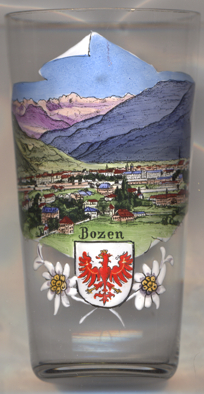
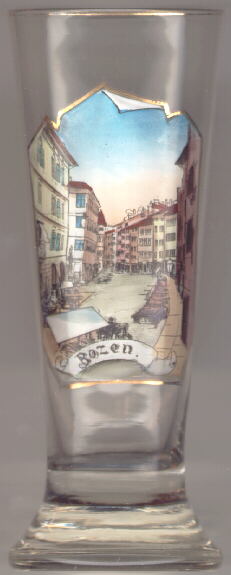 Bozen (Italian: Bolzano, Ladin: Bulsan) is situated at an elevation of 262 m at the confluence of the rivers
Etsch (Adige), Eisack (Isarco) and Talfer (Talvera). Archeological traces of prehistoric settlements are only found in the vicinity
at the mountain slopes because the valley basin was occupied by swamps and was frequently afflicted by floodings.
The first settlement at the modern location of Bozen originated in Roman times as a military post.
This settlement became known as Pons Drusi (ca. 15 BC) and later developed into a small
town, which was first mentioned as Bauzanum in about 680. The Romans were followed by
the Goths, Franks, Langobards, and Baiuvarii.
Bozen (Italian: Bolzano, Ladin: Bulsan) is situated at an elevation of 262 m at the confluence of the rivers
Etsch (Adige), Eisack (Isarco) and Talfer (Talvera). Archeological traces of prehistoric settlements are only found in the vicinity
at the mountain slopes because the valley basin was occupied by swamps and was frequently afflicted by floodings.
The first settlement at the modern location of Bozen originated in Roman times as a military post.
This settlement became known as Pons Drusi (ca. 15 BC) and later developed into a small
town, which was first mentioned as Bauzanum in about 680. The Romans were followed by
the Goths, Franks, Langobards, and Baiuvarii.
In the 11th century, Bozen came in possession of the
bishops of Trient (Trento) who founded the modern town. During the 12th and 13th centuries
the town was enlarged, fortified, and also received a town charter. After the death of the last count of Eppan in 1248
Bozen came in possession of the counts of Tirol, who were followed by the counts of Görz (Gorizia) and Tirol in 1253
and the Habsburgs in 1363. Since then Bozen was part of the Austrian countries.
When the capital of the county of Tyrol was moved from Meran to Innsbruck in 1480,
Bozen soon became the regional administrative centre of South Tyrol.
After the Peace of Pressburg (Bratislava, SK) in 1805, Tyrol had to be handed over to Bavaria in 1806. After the
defeat of the Tyrolean liberation movement and the Peace of Schönbrunn (see Vienna) in 1809,
North Tyrol and the northern part of South Tyrol remained Bavarian, but Bozen and the
southern parts of South Tyrol were awarded to the Napoleonic Kingdom of Italy in 1810. Tyrol was recaptured by Austria in 1813, which was
confirmed by the Congress of Vienna in 1815.
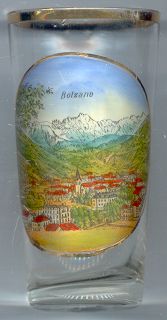
Until the mid-19th century, the town retained its medieval appearance. After that it quickly became popular as a tourist destination.
Especially the town borrough of Gries became renowned as a climatic spa.
The opening in 1867 of the railroad, which leads north to North Tyrol and Bavaria via the Brenner pass and
south to Trento and Italy, further boosted the economy of the city. After World War I Bozen became part of
Italy in 1919/20. Today, Bozen is the capital of the autonomous province of Bozen-Südtirol (Bolzano-Alto Adige).
Glass no. 2092 [left] shows the
The
Another glass of this collection shows the Walther monument in
Duchcov, Czech Republic.
The 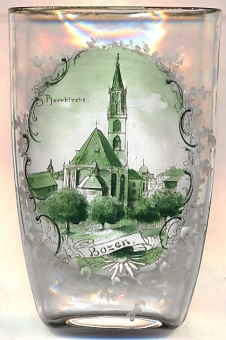
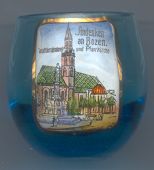 The
The  cathedral Mariä Himmelfahrt (Ascension of Our Lady) [left]
was first mentioned in 1184 and by 1238 had obtained the status of a parish church. After several fires the church
was largely rebuilt from the 14th century onwards. Most of ther Romanesque parts were removed and were replaced
by Gothic structures. The spire (63 m high) was added in 1500–1519. The Baroque main altar of 1719 was largely
destroyed during World War II, but was reconstructed until 1959.
The former main altar (1421–1423), whose parts today are found in several museums,
was a masterpiece of the master sculptor Hans of Judenburg.
The Baroque chapel of grace was added in 1745 and houses the statue of Our Lady. A further object of veneration
is the painting of The Sacred Heart of Jesus, created in the late 18th century. In 1964 the church, now co-cathedral,
became the seat of the bishops of Bozen-Brixen; at the same time, the diocese of Bozen-Brixen was
created out of the former diocese of Brixen / Bressanone and parts of the archdiocese of Trent
(Trento/Trient).
cathedral Mariä Himmelfahrt (Ascension of Our Lady) [left]
was first mentioned in 1184 and by 1238 had obtained the status of a parish church. After several fires the church
was largely rebuilt from the 14th century onwards. Most of ther Romanesque parts were removed and were replaced
by Gothic structures. The spire (63 m high) was added in 1500–1519. The Baroque main altar of 1719 was largely
destroyed during World War II, but was reconstructed until 1959.
The former main altar (1421–1423), whose parts today are found in several museums,
was a masterpiece of the master sculptor Hans of Judenburg.
The Baroque chapel of grace was added in 1745 and houses the statue of Our Lady. A further object of veneration
is the painting of The Sacred Heart of Jesus, created in the late 18th century. In 1964 the church, now co-cathedral,
became the seat of the bishops of Bozen-Brixen; at the same time, the diocese of Bozen-Brixen was
created out of the former diocese of Brixen / Bressanone and parts of the archdiocese of Trent
(Trento/Trient).
[https://de.wikipedia.org/wiki/Maria_Himmelfahrt_(Bozen)]
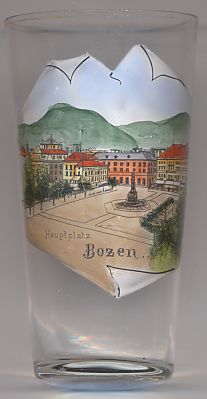
 Hauptplatz
Hauptplatz Waltherdenkmal (monument for Walther von der Vogelweide) [foreground]
commemorates one of the most famous German minstrels who lived from around 1170 until about 1230.
The monument was created in 1889 by the sculptor Heinrich Natter. (As an Italian counterpart, the monument for Dante
Alighieri was created in Trento in 1896.) Plans to remove the monument were not
carried out in 1926, but in 1935 it was moved to the Rosegger-Park. It remained there until 1981 when it was moved back to
its original location.
Waltherdenkmal (monument for Walther von der Vogelweide) [foreground]
commemorates one of the most famous German minstrels who lived from around 1170 until about 1230.
The monument was created in 1889 by the sculptor Heinrich Natter. (As an Italian counterpart, the monument for Dante
Alighieri was created in Trento in 1896.) Plans to remove the monument were not
carried out in 1926, but in 1935 it was moved to the Rosegger-Park. It remained there until 1981 when it was moved back to
its original location.
[https://de.wikipedia.org/wiki/Walther-Denkmal_(Bozen)]
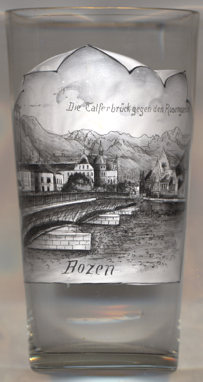 The
The  Talfer Bridge [near left, no. 3727] spanning the river Talfer
connects the city districts Zentrum-Bozner Boden-Rentsch and Gries-Quirein. The five-span cast-iron bridge was built
in 1899–1900, replacing a stone bridge of the early 19th century. Older bridges across the river Talfer had been
documented since the 14th century. A tram lince crossed river using this bridge between 1907 until 1948. In the late
1930s plans wer made to replace the bridge with a more modern bridge that was to be named 'Ponte Claudio'; however, these
plans were abandoned following massive public protests. Closed in 1975 the bridge was re-opened after comprehensive
renovation in 1990.
Talfer Bridge [near left, no. 3727] spanning the river Talfer
connects the city districts Zentrum-Bozner Boden-Rentsch and Gries-Quirein. The five-span cast-iron bridge was built
in 1899–1900, replacing a stone bridge of the early 19th century. Older bridges across the river Talfer had been
documented since the 14th century. A tram lince crossed river using this bridge between 1907 until 1948. In the late
1930s plans wer made to replace the bridge with a more modern bridge that was to be named 'Ponte Claudio'; however, these
plans were abandoned following massive public protests. Closed in 1975 the bridge was re-opened after comprehensive
renovation in 1990.
[https://de.wikipedia.org/wiki/Talferbrücke]
 Rosengarten group (Italian: Catinaccio; Ladin: Ciadenac, Ciadenáze)
[near left, no. 3727: background] is a massif in the Dolomites, located between the valleys Tierser Tal
and Eggental in South Tyrol and the Fassa Valley in Trentino. One peculiarity of the Rosengarten is the pink shade, owing to
the presence of the mineral dolomite, which takes in the sunset and "glows", as celebrated in the 'Bozner Bergsteigerlied'.
Meaning "Rose garden" in German, the name refers to the legend of King Laurin and his Rose Garden, a traditional story
explaining the appearance of the mountain range.
Rosengarten group (Italian: Catinaccio; Ladin: Ciadenac, Ciadenáze)
[near left, no. 3727: background] is a massif in the Dolomites, located between the valleys Tierser Tal
and Eggental in South Tyrol and the Fassa Valley in Trentino. One peculiarity of the Rosengarten is the pink shade, owing to
the presence of the mineral dolomite, which takes in the sunset and "glows", as celebrated in the 'Bozner Bergsteigerlied'.
Meaning "Rose garden" in German, the name refers to the legend of King Laurin and his Rose Garden, a traditional story
explaining the appearance of the mountain range.
[https://en.wikipedia.org/wiki/Rosengarten_group]
![[scale]](lineal.jpg)